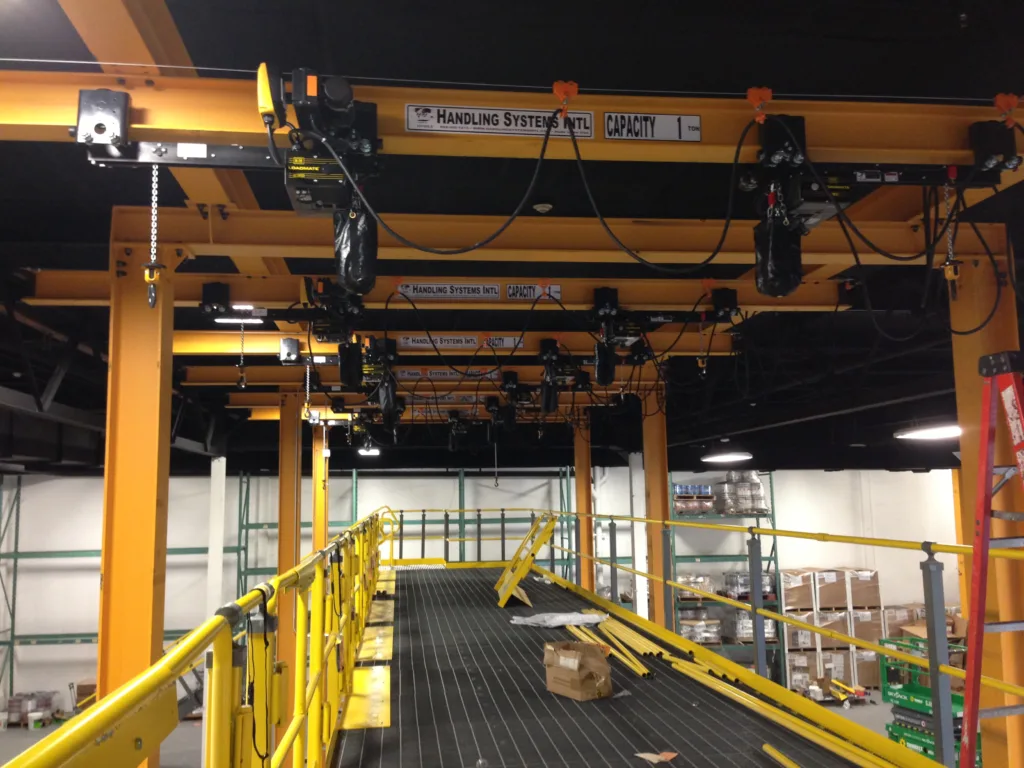When comparing jib cranes to overhead cranes, it’s important to understand their distinct characteristics, applications, and advantages. Let’s explore the key differences between these two types of material handling equipment.
Jib cranes are characterized by their simple design, consisting of a horizontal boom attached to a vertical mast or wall.
Key Features:
- Rotational movement (180° to 360°)
- Compact and space-efficient
- Ideal for workstations and confined spaces
- Typically lower load capacity
- Can be wall-mounted, floor-mounted, or column-mounted
Applications:
- Assembly lines
- Loading docks
- Maintenance bays
- Individual workstations
Overhead cranes, also known as bridge cranes, consist of a bridge that moves along elevated runways, with a hoist that travels across the bridge.
Key Features:
- Large rectangular coverage area
- Higher load capacity
- Multiple axes of movement (up/down, left/right, forward/backward)
- Can span entire facilities
- Often integrated into building structure
Applications:
- Warehouses
- Manufacturing plants
- Distribution centers
- Heavy industrial facilities
Comparison
| Feature | Jib Crane | Overhead Crane |
|---|---|---|
| Structure | Boom attached to single support | Bridge supported by runways |
| Coverage Area | Circular | Rectangular |
| Load Capacity | Generally lower | Higher (can exceed 100 tons) |
| Space Requirements | Compact, ideal for confined spaces | Requires more overhead space |
| Installation | Can be wall, floor, or column-mounted | Often integrated into building structure |
| Customization | Various boom lengths and capacities | Multiple configurations available |
| Cost | Generally less expensive | More expensive, especially for larger systems |
Choosing Between Jib and Overhead Cranes
When deciding between a jib crane and an overhead crane, consider the following factors:
- Available Space: Jib cranes are more suitable for confined spaces and individual workstations, while overhead cranes require more overhead space but offer greater coverage.
- Load Capacity: If you need to lift heavy loads, an overhead crane is likely the better choice due to its higher capacity options.
- Coverage Area: Jib cranes cover a circular area, while overhead cranes cover a rectangular area. Choose based on your workspace layout and lifting needs.
- Frequency of Use: Jib cranes excel in applications requiring frequent lifting within a specific work area, while overhead cranes are better for facility-wide material handling.
- Cost: Jib cranes are generally less expensive than overhead cranes, making them a cost-effective solution for lighter loads and localized lifting needs.
- Building Structure: Overhead cranes often require integration with the building structure, while jib cranes can be more easily installed in existing facilities.
- Flexibility: Jib cranes offer more flexibility for individual workstations, while overhead cranes provide broader coverage and are better suited for moving materials across larger areas.
By understanding these differences, you can select the crane type that best suits your specific operational requirements, workspace constraints, and budget considerations. Both jib cranes and overhead cranes have their unique advantages, and the right choice depends on your specific material handling needs.

